#two full length television seasons
Explore tagged Tumblr posts
Note
A couple of Timeless posts have crossed my dash recently (at least one from you) which kicked off a rewatch for me last night. And now I find that you've written fic for S3 and S4? Saving me from That Ending? Excellent! I adore your Dreamling stories so I'm sure these will not disappoint! I'm assuming you pick up after the last ep of S2 then?
Oh my friend, I HAVE EXCITING NEWS FOR YOU!
Not only did I write fic to save us all from the Abomination, but I wrote two full 13-episode television seasons, in proper script format and everything, for Timeless Season 3 and Season 4. They have fanart, lists of guest stars, and historical handouts, they were launched in weekly format with advance reviews and teasers and released at Sunday 8pm, and otherwise were done as close to actual television episodes as we could without them being, y'know, filmed.
Hasten ye to @timeless-season-four and click on "Episodes", wherein you will able to access the download links for the scripts and all the other content associated with each episode. They start with 3x01, "Chinatown Part 2," and carry through 4x13, "Homecoming." My seasons 3 and 4 finish the whole series/story arc, and if I say so myself, they're pretty damn good.
Enjoy!!
#lunaris1013#ask#timeless s3#timeless s4#when i say i am nothing if not motivated by spite#THIS IS WHAT I MEAN#two full length television seasons#anyway i regret nothing
23 notes
·
View notes
Text
I was on a plane this weekend, and I was chatting with the woman sitting next to me about an upcoming writer’s strike. “Do you really think you’re mistreated?” she asked me.
That’s not the issue at stake here. Let me tell you a little something about “minirooms.”
Minirooms are a way of television writing that is becoming more common. Basically, the studio will hire a small group of writers, 3-6 or so, and employ them for just a few weeks. In those few weeks (six weeks seem to be common), they have to hurriedly figure out as much about the show as they can -- characters, plots, outlines for episodes. Then at the end of the six weeks, all the writers are fired except for the showrunner, who has to write the entire series themselves based on the outlines.
This is not a widespread practice, but it has become more common over the past couple of years. Studios like it because instead of paying for a full room for the full length of the show, they just pay a handful of writers for a fraction of the show. It’s not a huge problem now, but the WGA only gets the chance to make rules every three years -- if we let this go for another three years and it becomes the norm? That would be DEVASTATING for the tv writing profession.
Do I feel like I’m mistreated? No. I LOVE my job! But in a world of minirooms, there is no place for someone like me -- a mid-level writer who makes a decent living working on someone else’s show (I’d like to be a showrunner someday, but for now I feel like I still have a lot to learn, and my husband and I are trying to start a family so I like not being support rather than the leader for now). In a miniroom, there are only two levels -- the handful of glorified idea people who are already scrambling to find their next show because you can’t make a decent living off of one six-week job (and since there are fewer people per room, there are fewer jobs overall, even at the six-week amount), and the overworked, stressed as fuck showrunner who is going to have to write the entire thing themselves. Besides being bad for me making a living, I also just think it’s plain bad for television as an art form -- what I like about TV is how adaptable it is, how a whole group of people come together to tell a story better than what any of them could do on their own. Plus the showrunner can’t do their best work under all of that pressure, episode after episode, back to back. Minirooms just...fucking suck.
The WGA is proposing two things to fix this -- a rule that writers have to be employed for the entire show, and a rule tying the number of writers in the room to the number of episodes you have per season. I don’t think it’s unreasonable. It’s the way shows have run since the advent of television. It’s only in the last couple of years that this has become a new thing. It’s exploitative. It squeezes out everyone except showrunners and people who have the financial means to work only a few months a year. It makes television worse. And that is the issue in this strike that means everything to me, and that is why I voted yes on the strike authorization vote.
50K notes
·
View notes
Text
next level
lando norris
request: “Just let me finish this/this level and i swear ill go down on you until you cum at least three times.” w/ Lando Norris 43. “just let me finish this/this level and i swear ill go down on you until you cum at least three times.”
tags: smut/pwp, established relationship, teasing& seduction, video games, cough sex, cowgirl position
eros (the valentine's day collection)

just because it wasn't sim racing, doesn't mean it didn't require lando's full attention. but it was hard to beat the level when his loving, beautiful girlfriend would not get away from the front of the television.
he wouldn't deny it, you were beautiful. but lando had been trying to beat his level for over an hour, and he was so close before you stood in front of the television screen. your arms crossed and your hip cocked slightly to the side. your gaze stayed on him as he tried to see the screen behind you.
"lando... it's eleven-forty. time for bed."
he exhaled and said, “just let me finish this level and i swear ill go down on you until you cum at least three times.” his words were promising. but with the season around the corner, the future world champion needed his rest. and you knew exactly how to get him settle for the evening.
he breathed a sigh of relief when you moved away from the television and towards him on the couch, you were pressed right up against him and pushed back his curls. you chuckled lowly and he tensed up a little.
"honey. baby. please." he said.
"i'm not doing anything. you wanted to keep playing, then keeping playing." your hand trailed across his clothed chest, you added a little pressure when your thumb grazed his nipples. sensitive spot. you were breaking out all the stops for this.
you touched his skin and he tried to navigate the level, he could feel the tightness in his sweatpants from your tender touches. his focus was split between the difficulty of the level and when you were going to do next. hard to say what you were going to do, your expression was unreadable.
"honey." he said.
"focus, lando." you cooed before your hand dipped lower and you grasped his hardening cock through his sweatpants. you chuckled lightly to yourself as you watched him squirm. trying his best to focus.
you could see the muscles of his neck move as he swallowed, the feeling was getting in his head. it was cute, to see him squirm. but he was so determined to finished this level. you were just providing moral support!
"oh shit, right there." he muttered as he missed the jump in the level and had to restart. you rubbed his cock through his sweatpants and you watched him squirm a little. his length throbbed under your touch and you smiled a little. how cute.
you chuckled lightly and continued to tease his cock, you watched him struggle and admired the sight of him. he looked sweet as he tried to fight back the pleasure that coursed through him. you watched him fail the level again and again and once more before he threw the controller to the side and grabbed you.
"come here." he said as he pulled you close to him. he got you up in his lap with his hands in your sweatpants and under your underwear. he kept his gaze on you as he rubbed your slit against his talented fingers.
"someone's needy." you remarked with a small laugh. you took him by the face and pulled him in for a hot kiss. he groaned against your lips as you rubbed yourself up against him. it felt beautiful, you felt like a dream.
when he pulled away, he looked up at you and remarked, "well, i think i just had a revelation. your hot pussy is a lot better than video games." then continued to rub your clit before you got your bottoms off.
your wetness rubbed against the fabric of his grey sweatpants. you felt the curl of excitement through you as the two of you moved against each other on the couch. you rubbed up against each other and it left you both feeling hotter.
his hands gripped your bare ass he looked up at you, there was a lustful twinkle in his eye and you smiled down at him. he looked good under you. he gave you ass a light slap, "fuck you're hot."
you held him by his cheeks and said, "and you're hotter when you're not wasting your evening on video games." then kissed him once more before you got his cock out of his sweatpants. you rubbed yourself up against his leaky length before you sank yourself on him.
"lando. fuck." you exhaled.
he moaned into the next kiss and held you tighter, helped you onto him. you took him beautifully, he slipped in without much struggle. and it only made him relax against the couch a little more. it was a hot feeling, you made a fire burn inside of him with each of your slow thrusts.
you held onto his shoulders and moved your body. your worked yourself on his cock as you kept kissing him. heavy breathing and small moans filled the living room air underneath the loud sound of the video game's music. he held on tightly and guided you up and down his cock. the two of you seemed to move at a similiar pace with no words spoken.
he understood you and you understood him. when you broke away from the kiss, the two of you gazed at one another. lando soon buried his face between your clothed breasts and groaned, "fuck, that feels good. right there, fuck, baby." he shuddered from the intense pleasure of it all.
he felt like a fool for ignoring you, but thankful that you were determined. because with your slick cunt around his cock, the pleasure felt better than any stress of the game. he groaned once more into your chest and you pulled his hair a little.
"see." you said, "should've just come to bed. got all comfy under the covers and let me ride you until you saw stars. i know i'm better than that stupid game, and i'm glad i could make you see the error of your ways." your voice was cheeky and lando just groaned against you.
"you're right, you're right." he panted.
it was no secret that lando loved your pussy, he loved having sex with you. you could recall when he was on the road and he was near begging for photos of you. not even nudes. just something to tide him over until he could smother himself in your love. to him you were divine and he wanted to bask in your holiness.
the two of you continued to move together under the bright light of the television screen. it was late in the evening, you two should be in bed. and while having sex on the couch wasn't your ideal location for fucking, it still felt nice.
lando's cock was snug inside of you and it made you toes curl from the pleasure. the thrumming of your heart while you moved against him left you panting and lustful for the man you had your arms wrapped around. you kissed him once more, moans were shared and you felt the pleasure rise in your body like steam over hot water.
at least lando could admit that it felt better. to fuck you was a treat that he indulged himself in and as he moved harder against you, he wanted more. you moaned into the kiss and he gripped your ass once more before he wrapped both arms around your middle tightly. it gave him better leverage to fuck you with.
your noises got hotter and more needy, the lust was intense in your core. the two of you moved quickly against one another as the pull of orgasm drew closer. you whined, he panted when the kiss was broken. you were both needy for one another.
"i'm close." you whined.
he held on tightly and said, "then cum for me. c'mon, fuck. i need it. cum for me and i'll spend the rest of the night eating out that fucking beautiful pussy until you can't cum anymore." his breathing was heavy.
you dug your nails into his back and with a few more thrusts of your hip, you finished on his cock. when you slowed down, lando worked up into you faster. your noises were higher pitched and the feeling radiated through you.
he came soon after with his face between your chest. he tensed up for a moment as he came then relaxed. he panted against your soft t-shirt as he relaxed a little bit. he shakily exhaled and pulled his head away, "wow."
you chuckled and kissed him gently on the lips, "i know. i guess it's time for bed." you winked at him.
lando reached for the control, "one more try of the level... then i'll go bed." he booted the game up again with his semi-hard cock still inside of you.
you gave him a death glare. next time, you promised yourself, you'd drag him by the ears to bed if you had to. <3
#bunny writes#formula 1#reader insert#f1 smut#formula one imagine#formula one smut#formula one fanfiction#f1 x reader#formula one#f1 fic#f1 fanfic#lando norris imagine#lando smut#lando norris fanfic#lando norris smut#lando norris x reader#lando x reader#lando norris#ln4 smut#ln4 x reader#ln4#ln4 mcl#ln4 imagine#ln4 fic
954 notes
·
View notes
Text
I knew when I gave my stepfather all twelve seasons of The Big Bang Theory I would likely be watching some of it with him, and it's a real experience. I watched a couple of early seasons of the show when it was airing, partly because my folks liked it so it was something we could text about and bond over, but I was usually half-paying attention.
When my stepdad put on a couple of episodes from the season nine DVD, at first I thought we were watching a clip compilation of some kind, because they were jarringly abrupt -- most scenes only seem to last about thirty seconds and rarely are you in one for more than two minutes; often the scenes seem to cut off prematurely. A lot of the time you can read from context what happens next in a scene, but the actual action of it is skipped over in favor of leaping to another weird mini-scene.
There are even sometimes scenes where within the action of the moment there's a slice of conversation very clearly missing -- for example, three of the characters are testing out a retinal scanner, and after finding that it works in conventional ways, two of them try to fool it by showing it one of each of their eyes to scan. But between the "this is how it works" moment and the "let's try and trick it" moment, there's a really rough cut where them coming up with the idea to trick it was clearly meant to go.
It's evident that this was done to tell the most story in the least amount of time, since at this point in television even a 22-minute sitcom was pushing the boundaries of length. But in a way I think it also suggests some reasons the show was so popular. Watching a show cut in this way, your own mind is doing about 40% of the storytelling, and if you're telling a story to yourself you're more likely to enjoy it than when you're being told a full cohesive story, since you have more control over the narrative and can tailor it to your preferences.
It's truly wild to see a fevered collage of mildly suggestive innuendo and jokes designed to appeal to a 4chan teen from 2005 semi-convincingly pass itself off as a narrative, and be viscerally aware that it did it for twelve years.
418 notes
·
View notes
Text
Cosplay the Classics: Elizabeth Montgomery in “Two”

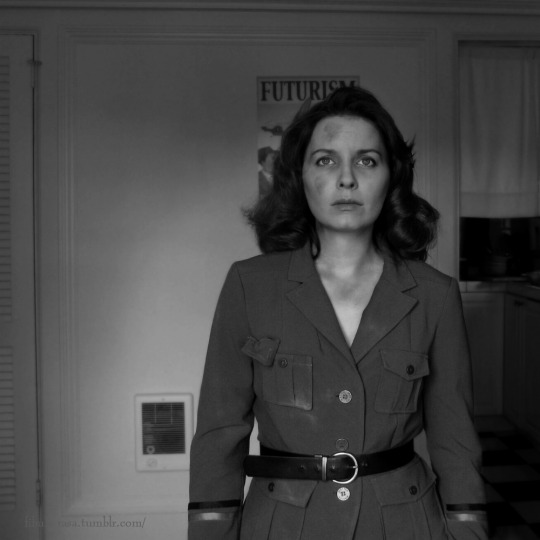

“Two” first aired on 15 September 1961 and is the first episode of the third season of The Twilight Zone. Sadly, “Two” is the only episode that features Elizabeth Montgomery.
Montgomery was nearly ten years into her professional career in 1961. She had already carved out a solid resume in television, appearing prolifically on anthology and episodic shows and occasionally stretched her legs on the New York stage. Samantha Stephens was still three years away when Montgomery took her voyage through The Twilight Zone.
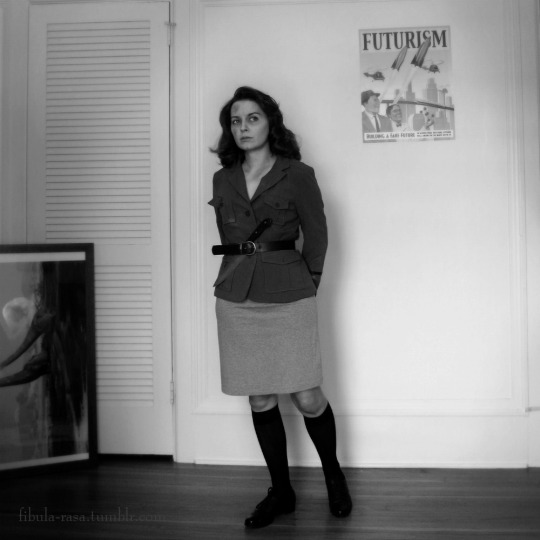

In its five seasons, The Twilight Zone was a crossroads of up-and-coming and well-established performers. “Two” paired the rising star Montgomery with Charles Bronson, who had a decade more acting experience in TV and film than Montgomery. Though Bronson was the more established star, “Two” is Montgomery’s showcase.

Read on below the jump!
“Two” relies on minimal dialogue throughout and notably Montgomery only has a single line spoken. The role relies almost entirely on Montgomery’s action/reaction, expression, and styling. The episode begins on Montgomery as The Woman wandering an abandoned city. The first nine minutes of the episode pass with no dialogue, with context given by visual elements and Serling’s opening narration. The entire episode takes place on a small section of city street (at the old Hal Roach studios, conveniently already in disrepair).
We learn through newspapers and magazines that this city is in The Man’s homeland, invaded by The Woman’s nation’s army. Signs of the city’s long five-year abandonment are everywhere, including full skeletons left where they fell. (The macabre element of skeletons is used sparingly across the Twilight Zone and usually in circumstances less grounded in reality than “Two,” such as “Long Live Walter Jameson” and “Queen of the Nile.”) As The Man mulls over his first encounter with The Woman a dove flies up behind him as a symbol of his genuine desire for peace. Through a variety of posters and advertisements, we learn that The Man’s homeland had a culture heavily invested in war.
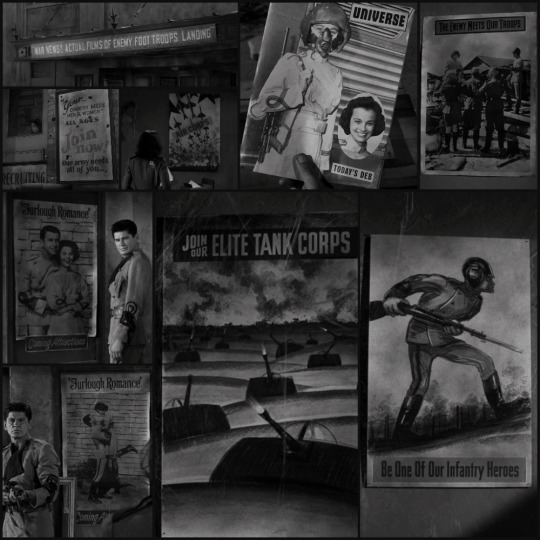
Collage of the war-related paraphernalia in “Two”
All of that is solid storytelling, but Montgomery’s acting adds an extra something. When The Woman first encounters The Man, Montgomery performs hair-trigger reactivity. Despite The Woman’s dire situation—a stranded foreigner in a decimated country with seemingly no chance to ever return home—her reluctance to trust The Man is significant. Pairing Montgomery’s wordless portrayal of these responses with the jingoistic quality of The Man’s homeland and the notable length of time that the city has been abandoned makes me feel that her feelings might not be a simple holdover of wartime hostility on her part but potentially extended trauma. Perhaps The Woman had previous awful experiences with other straggling remnants of The Man’s military, who may not have been as ready as The Man to give up wartime attitudes in spite of the war clearly being over.
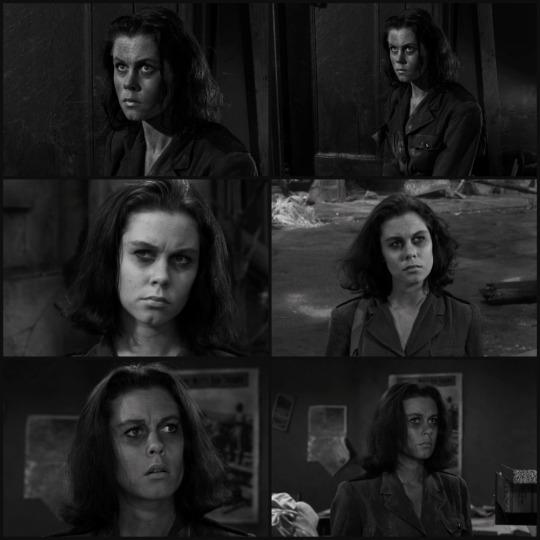
The Woman is understandably acting like a cornered animal. As the episode progresses, The Man tries to be as calculated as possible in communicating to The Woman that he doesn’t want a fight through his actions, turning his back to her, and not retaliating the third time she launches an attack on him. Montgomery, in turn, does a great job of drawing out the cornered animal characterization—alternating between curiosity, hope, mistrust, and open hostility. Montgomery’s characterization gives the role the added dimension that saves the episode from feeling too much like an overly simple fable.
Unfortunately, it’s in executing the fabular aspect of the story where “Two” falters. The opening narration by Serling specifies:
“It’s been five years since a human being walked these streets. This is the first day of the sixth year as man used to measure time. “The time: perhaps a hundred years from now, or sooner, or perhaps it’s already happened two-million years ago. The place: The signposts are in English so that we may read them more easily, but the place is The Twilight Zone.”
It’s established here that the location is meant to be a stand-in for any city in any country, and that the use of English is merely a storytelling convenience. So, even though “Two” is intended as a Cold-War era anti-war statement, they are intentionally distancing the fiction from the contemporary real-world conflict. To create further distance from a contemporary place/time, they establish that the rifles are laser guns.
But, then, that one line that Montgomery speaks in “Two,” seventeen minutes in, is “Prekrasny” or “прекрасны,” a Russian word for beautiful or pretty. This pretty much grinds to a halt the concept that this is a cautionary fable and not a vision of a dark future where the Soviet Union and the United States moved to open warfare. While I’ll admit that the conventions used to establish “Two” as a fable are cheeky and a little on the corny side, the episode itself would have been stronger without the suggestion that The Woman is Russian.
I’m not sure who made the call to use a Russian word. I wonder if perhaps Serling wrote his introduction and he had a different read on the story than its writer, Montgomery Pittman. Maybe Pittman intended “Two” to be more of a dark premonition with a twist of optimism and Serling thought of it more as a fable and the two approaches hampered each other in the final product? This is pure speculation on my part of course, but it’s a black mark on what I think could have been an even better episode than it is.
Regardless, I think “Two” is a strong episode and a fine example of a Serling-esque story written by someone brought on to lighten the load of Serling, who worked himself to the bone on Twilight Zone. I also appreciate Pittman’s confidence to rely so heavily on visual storytelling techniques, taking into account that the high quality at which we watch the show now does not reflect the quality home viewers would have had in 1961. It reflects both Serling and the producers belief that viewers would be fully engaged in watching the show as it aired rather than just passively having it on in the family room while unwinding after dinner.
Elizabeth Montgomery’s performance heightens the whole affair considerably. That’s no shade on Charles Bronson, in fact I think the monologuing he’s given could have come off as unbearably hokey if delivered by a lesser actor.
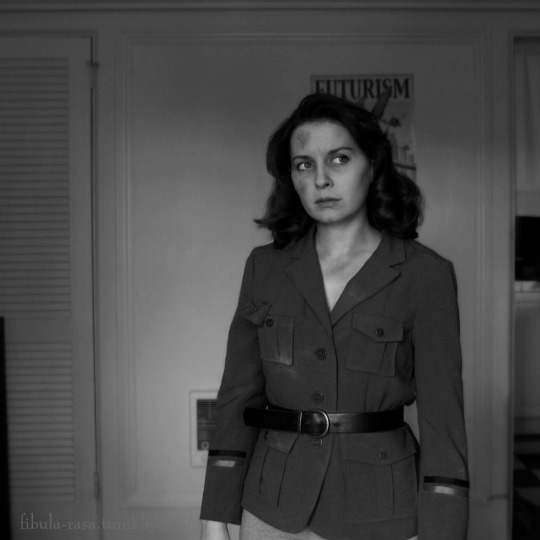
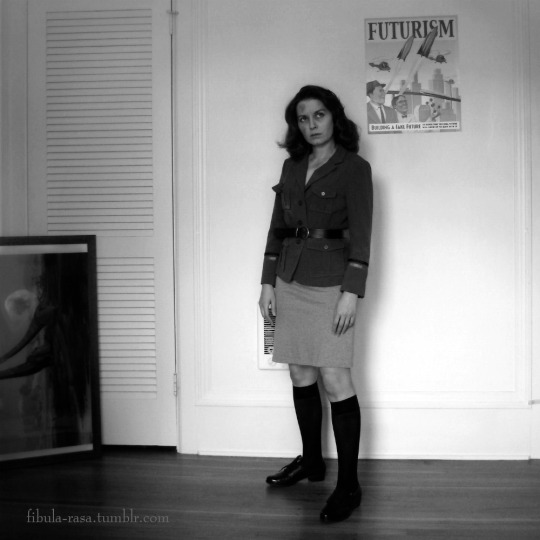
If you can believe it, this is my very first time cosplaying The Twilight Zone! (Though I did play Rod Serling in a set of sketches in high school. I was as weird as a teenager as I am an adult, okay?) If you didn’t already know, I run another blog called Twilight Zone in Close-ups, examining the powerful use of close-up shots on the show by testing out how much of each episode’s story can be communicated solely by its close-up shots.
☕ Buy me a coffee! ☕
#1960s#1961#elizabeth montgomery#the twilight zone#Twilight Zone#rod serling#classic television#television#closet cosplay#cosplay#television history#OTD#science fiction#speculative fiction#horror#1960s tv#tv
211 notes
·
View notes
Text
MONTHLY MEDIA: January 2025
New year, same me.
……….FILM……….
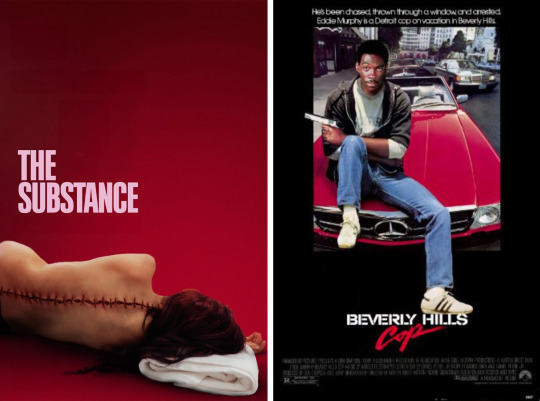
The Substance (2024) Despite not liking horror or needles, I was really excited for this. The premise sounded great and then I sit down and see a 2+ hour runtime and start getting nervous. Did I love everything about this movie? Yes. Do I think they could've done it in an hour thirty or an hour forty-five? Yes. Except the last 20ish minutes; keep that exactly as it is.
Beverly Hills Cop (1984) I knew this movie was written for Sylvester Stallone but I didn't realize that almost all of the comedy would stem from Eddie Murphy. Without him (or his stellar wardrobe), I suppose it's just a fairly straightforward crime/detective movie. Just an incredible performance.
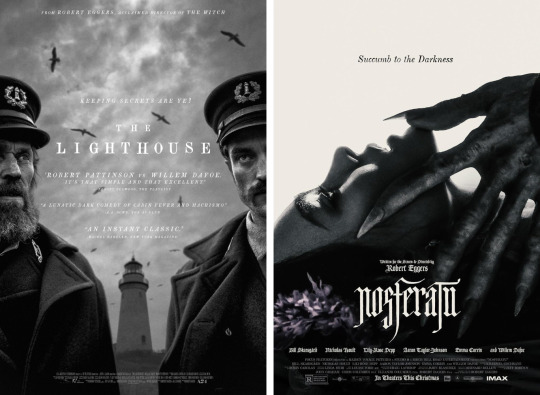
The Lighthouse (2019) As someone who also lives where they work and does so in (mostly) isolation, I'm glad I watched this when I didn't have looming deadlines or the urge to get back to work. Anyway love a good fairytale movie and this is a good fairytale movie.
Nosferatu (2024) Watched this shortly after The Lighthouse and while it was fun to see overlapping visuals and themes, I kinda wished it was...weirder? Still so many beautiful scenes and bold performances, but not nearly as unhinged as I was expecting.
……….TELEVISION……….
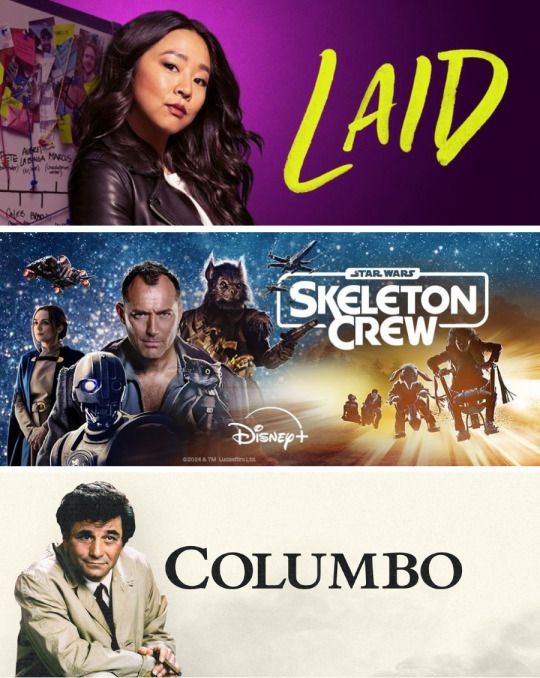
Laid (Episode 1.01 to 1.08) Fun and funny and, for something that acknowledges the pandemic, really strikes a good balance of feeling contemporary but not immediately dating itself. I'm torn on the ending but it's definitely more hits than misses here.
Skeleton Crew (Episode 1.05 to 1.08) A nice breezy adventure. Perhaps expecting a few more narrative beats or one-off adventures but really I can't complain with what this is: an all-ages entry in the Star Wars universe that stands on its own.
Columbo (Episode 2.06 to 2.08) Some really fun...villains/murderers this season and I love the recurring doctor/vet visits. Peter Falk's comedic timing and charisma are on full display this season.
……….YOUTUBE……….

The Alt-Right Playbook x PhilosophyTube: Doublewrong by Innuedo Studios Don't fall into the trap of meeting a value-driven discussion with facts and logic. It doesn't work. Instead see where your values differ and focus on that. VIDEO
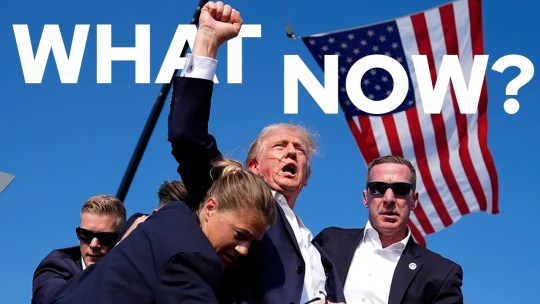
What Now? by Sophie from Mars This came out at exactly the right time (for me, at least). It's not denying the struggles ahead. Instead it's a perspective that sees a way through. Community above all else. VIDEO
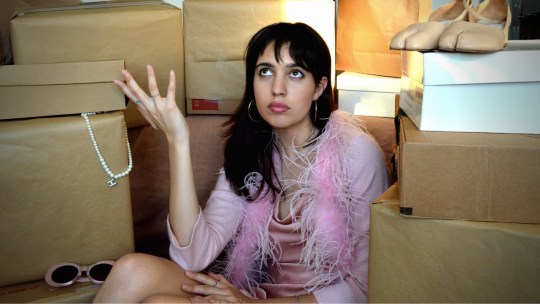
Why No One Wins the Fast Fashion Debate by Broey Deschanel A thoughtful look at both the fashion industry and global economics. VIDEO
……….READING……….
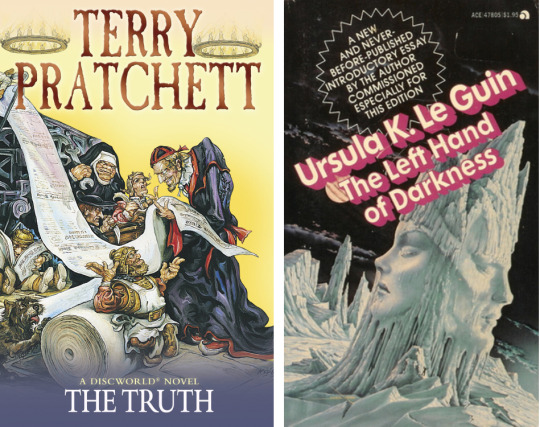
The Truth by Terry Pratchett (Page 45 of 442) Always a treat to spend more time in the Discworld and it's been a while since the main character is wholly new. It's refreshing.
The Left Hand of Darkness by Ursula K. Le Guin (Complete) Given how much I love Le Guin's Earthsea series, I was really excited for this. Maybe it was the length, maybe it was that it was sci-fi, but I found it to be a slog. I could feel how groundbreaking this must've been, and appreciate how relevant it still remains, but the long stretches of world-building and describing arctic travel/survival was not for me.
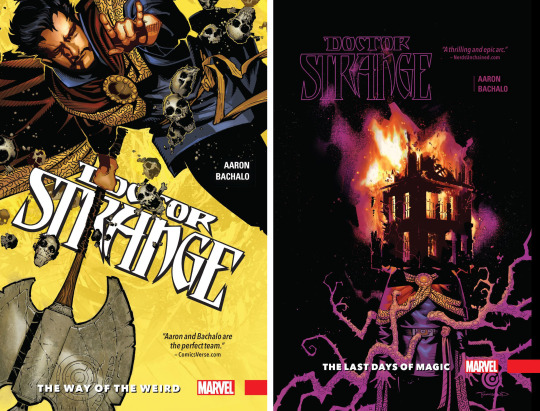
Doctor Strange Vol 1 and 2 by Jason Aaron, Chris Bachalo, and more (Complete) I read the Donny Cates run a few years ago and didn't realize this was set before that. While I didn't like that run, I'm digging the visuals and narrative here. Doctor Strange feels a little too...quippy, but that's just because I've always liked the contrast of a very serious lead with a whimsical and unexplained setting. Happy to keep going with this and see how it ties up!
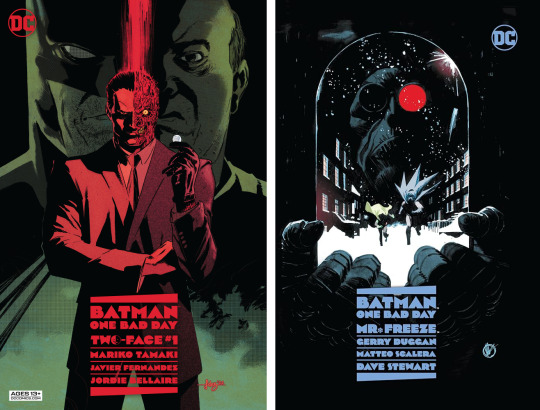
Batman - One Bad Day: Two Face by Mariko Tamaki and Javier Fernandez (Complete) A decent introduction to this series but it didn't really grab me. Great character writing but the...mystery....never really clicked.
Batman - One Bad Day: Mr. Freeze by Gerry Duggan &, Matteo Scalero (Complete) This, on the other hand, really worked for me and delivered everything I want out of a Batman comic: sympathetic villain, Bruce Wayne going undercover out of the costume, plucky Robin, and a cool bat suit. I'd definitely read this one again. Heck Mr. Freeze briefly has a sidekick called Frostbite! This is superhero comics at their best.
……….AUDIO……….
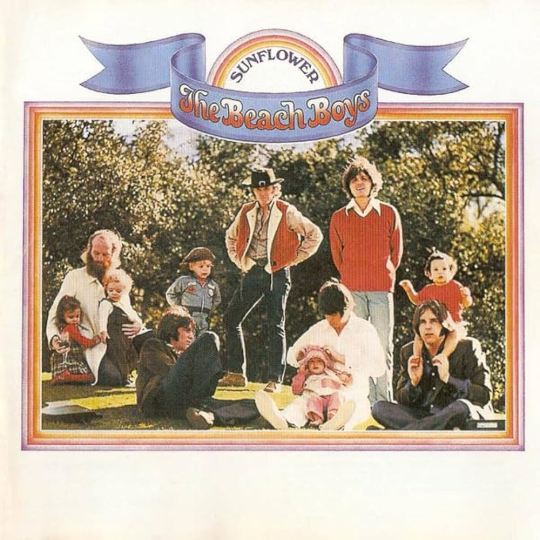
Sunflower by The Beach Boys (1970) Pet Sounds is one of my all-time favourite albums and yet I never really got into much of the other post-surf output from The Beach Boys. After seeing this review I dived in head first and now adore it. It really is a shame that they didn't blow up the same way as the Beatles, given how similar their musical trajectory was.
……….GAMING……….

Mika and the Witch's Mountain (Chibig) I don't really Kickstart video games so this was a gamble. The art direction and characters are great, but quickly realized there's really only one trick to this pony. I was even more frustrated that the trick (flying on a broom) never really clicked for me. There's potential here but it's not quite there yet for me.
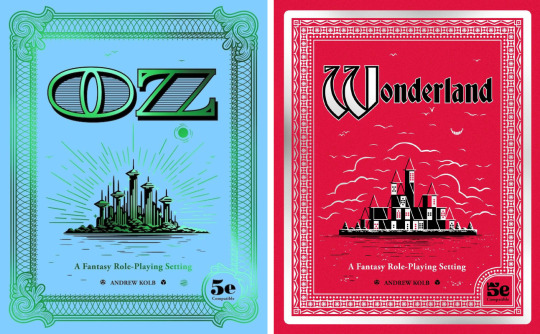
Oz: A Fantasy Role-Playing Setting (Andrews McMeel Publishing) The party is spinning so many plates that it's a marvel none of them have dropped yet. Right now they're investigating a murder tied back to their first session. You can read all about it here.
Wonderland: A Fantasy Role-Playing Setting (Andrews McMeel Publishing) The Mof1 crew got back together for a one-shot! We had two character deaths but a lot of loot and XP for those that survived.
And that's it. See you in February!
7 notes
·
View notes
Text

A year and a bit ago, I was procrastinating on Reddit as one does, scrolling through r/television's weekly What are you watching and what do you recommend? post, when one of the comments caught my eye.
Young Royals. It's gay and no one has aids.
It said.
That was it, nothing else.
Somehow at that moment that was enough for me to check it out, in a right time, right place kind of way, or maybe it was simply fate. It's certainly not how I've been recommending the show, and yet it worked.
I proceeded to binge Young Royals that night and the following day, giggling and crying and clutching my pillow telling my so that this this is the show I've been wanting all my life, and then I watched it again and again and wondered how I'd ever survive waiting over ten days for season 2 to come out. (cute, right?)
The solution was of course writing fic. And so over the next two days Their Own Medicine was born.
362,194 posted words later, and many more waiting in assorted wip documents and my dtf fic ideas notebook, we've reached the one year anniversary of me posting my first Young Royals fic.
And what a year it's been! Thank you so much everyone for this wonderful journey. I know I'm not always the best at answering comments or reblogging stuff (mostly because I'm shy and want to do it properly and plan out novel length replies in my head which then weirdly enough don't write themselves down), but words cannot express how much I appreciate all of you and how much the Young Royals famdom has come to mean to me.
I've met so many wonderful people and had so many thought provoking discussions, mused over a lot of fic ideas and chatted over what-ifs, it's truly enriched my life (and turned my procrastination time into fic writing time, which has certainly been much more enjoyable, sorry not sorry Reddit).
You all rock and I hope we have many more happy years full of fics and gifs and polls ahead of us. I for one can't wait for what's to come.
Cheers and I hope you have a nice Christmas!
69 notes
·
View notes
Text


Disney Branded Television Orders Kiff -Themed Halloween and Christmas Specials For 2024' Starting With "The Haunting Of Miss McGravy's House"
This Halloween season, Disney Channel and Disney Jr. have kids and families covered with an abundance of festive and fun programming for the whole family to enjoy together.
Between the announcements of Monstober, it was revealed that Disney Branded Television has ordered two-separate Kiff specials centered around Halloween and Christmas with the first special being "The Haunting Of Miss Gravy's House" slated for a October 5 at 7:30PM EST only on Disney Channel and streaming Wednesday, Oct. 16, on Disney+
youtube
Kiff: The Haunting of Miss McGravy’s House Halloween Special - Saturday, Oct. 5 at 7:30PM EST only on Disney Channel; Wednesday, Oct. 16, on Disney+ In this full-length special, Kiff and her friends haunt a house on Halloween to save it from being sold.
youtube
An album featuring songs from the special by Walt Disney Records and Brad Breeck is set to drop Friday October 4.
Both specials separate from S1 & S2 where ordered thanks to the sucess of the series on ratings and streaming since launch as Kiff is still one of the most streamed animated series on Disney+ and Disney Channel. Last week creators Nic Smal and Lucy Heavens where considered Disney Television Animation's most prolific creators alongside Dan Povenmire, "Jeff "Swampy" Marsh, Bruce W. Smith, Ralph Farqhuar, Noah Z. Jones , Craig Gerber, Rob LaDuca, Kim Duran, Aliki Theofilopoulos, Rachel McNevin, Chris Houghton, Shane Houghton, Stevie Wermers-Skelton,Kevin Deters, Ryan Gillis and Natasha Kline during The Walt Disney Company's 2024 Emmys.
#Kiff#Disney Kiff#Nic Smal#Lucy Heavens#Kiff: The Haunting of Miss McGravy’s House#Kiff The Haunting of Miss McGravy’s House#Disney Channel#Disney Television Animation Specials#Disney TVA Specials#Youtube
19 notes
·
View notes
Text
AtLA Book Water Soundtrack Review

You all know how we've wanted this soundtrack for years and suffered through such explanations as 'the original sound files probably don't exist anymore.' Thankfully, Avatar Studios has seen fit to re-record the music of the first season with a full orchestra, as part of what I assume is a media blitz meant to build hype for the live action Netflix remake. But we all know that remakes, even in music, often don't live up to the original. So, how did it turn out?
(Er, the soundtrack, I mean. The Netflix thing hasn't been released yet.)
With a sigh of relief, I can report: It's great!
Thankfully, the sample track didn't turn out to be indicative of the entire album. The composition of everything else is pretty faithful to the original versions, as far as I could tell. In fact, the overall sound is pretty close to my memories of the original music, despite the use of a full orchestra to record this version- with the exception of the drums, which in the HiDef sound files I downloaded sound fantastic and successfully make my floor and walls shake. (I make no guarantees about what you get if you listen to streaming, mp3 files, or the vinyl disks. This is why I pay a premium for FLAC files or CDs.) I loved turning up the volume and getting blasted by the classic Avatar theme in glorious orchestral quality.
Plus, some tracks are vastly improved by these recordings, while also being true to the original. The best example is the Northern Water Tribe entrance music, which I always thought sounded a bit chintzy and repetitive in the original track (but I admit my opinion might be colored by the poor quality of the recordings we have access to). The new version has a much fuller sound and enough variation to justify the length. I suspect this might come down to which of the original tracks used real instruments and which had to rely more on synthesized sound.
I suspect, though, that the vocals on this album are all the originals, and that's why the Koizilla music makes the chorus less prominent; it probably couldn't be mixed together with the new orchestra without sounding bad. In most cases, that's not a problem, but I do mourn that the Kozilla music doesn't sound quite right. But, on the other hand, Mako's singing has never sounded better.
The album has all the music I'd expect of a soundtrack for Book Water. The Fire Nation, Kyoshi Island, and Jet all get good suites that showcase their themes and music, something that just doesn't exist anywhere in the original recordings. The famous stuff -- the opening theme, the Avatar State, the 'into the sunset' peaceful music, the Agni Kai, Aang's antics, the full "Winter, Spring, Summer, & Fall" tune in both full instrumental form and with Mako's singing, and of course the ending credits -- is all here. The season finale is heavily represented, but that's appropriate as those episodes got a lot of new music and all of it is great. And if you've only been able to content yourself with the fan-made soundtracks we've had to piece together over the the years via promotional releases and episode rips, there's some good stuff here that you might never have heard by itself before, like the fun bit of music for June.
And because I'm compelled to nitpick, I'm a bit annoyed by the order of the tracks. I like to listen to soundtracks in chronological order, and while that kind of thing isn't really feasible with something as long and repetitive as a television series season, this album does a serviceable approximation with its order- except for two weird cases. The Blue Spirit introduction comes after the music for his escape with Aang, and the music for the encounter with Koh comes after the music for Aang's arrival in the Spirit World. I assume this is because it makes for a better hi/lo/fast/slow sequence as part of the overall, but I would have preferred the order of their presentation in the cartoon.
So, in conclusion, this is the soundtrack we've wanted all these years, and everyone should stream or buy it or at least pirate it in enough numbers to raise eyebrows. I want the other two books done this way, and I think we as a fandom deserve it, despite some of the fanfic I've seen you people write. ;)
35 notes
·
View notes
Note
i think, with the state of tv at present, your "it should have been a movie" stance makes sense.... honestly it's so frustrating that the full breadth and unique storytelling/artistic creation capable through television is no longer being utilized :/
(though this may be me projecting my own opinions on your statement)
ur right thats what i was getting at in my post. it definitely depends on the format of the show, but if a show with one singular plot focusing on a small group of characters stretched out over 8 episodes is definitely something that would benefit just being a movie. there is misused or too much padding to the plot to justify stretching it out. just comparing say like btvs season 2, 22 episodes, is about 15.4 hours of content. i just picked a random new show i remember watching a little bit of, which was fallout, and at 8 episodes it only has about 7.5 hours of content. which is just about half of the amount of content and has half of the amount of time to give characters and plots time to breathe. now fallout is a bit different in that its a video game adaptation but i feel like it could have benefited from either taking its existing plot of lucy trying to find her father in the wasteland and shaved it down to a feature length film, or lean onto the video game side quest model and have a full 22 episode season going on one off episodes doing "quests" like also moving towards the larger vault plot, tying in both maximus' and the ghoul's respective story arcs as well.
this is all subjective of course but just my two cents
#asks#its also incredibly subjective bc tv has never really been my favorite storytelling format#i am so much more of a movies and comics/graphic novels kind of guy
10 notes
·
View notes
Text
A Breakdown of Van Palmer’s NYC Monologue in S1E7 of Yellowjackets
Hey y’all! This is one of my favorite monologues from season one, so I wanted to do a quick breakdown on it before season two.
To fully appreciate Van’s monologue, I think we really need to consider the historical context. Although, it was only a little over two decades ago, 1996 was an entirely different world, especially for closeted lesbians growing up in suburbia. The first coming out episode in television history wouldn’t air until 1997 and gay marriage wouldn’t be legalized in the first state (Massachusetts) for another 8 years. Being out, or even just visibly queer, would’ve been dangerous in 1996 suburbia. Van was extremely brave to even be visibly butch back then, but I digress… I don’t want to dwell on the negatives of the time period, but I do think it’s important to remember the world Van and Taissa grew up in when thinking about their relationship.
The closet wasn’t a choice for Van or Taissa, it was obligatory. At least, staying closeted would’ve been essential for surviving in suburban New Jersey at the time.
Overall, Van’s NYC monologue is a confession… that she loves Taissa… that she wants to live to see a day that they can be out together. New York in the monologue is a metaphor for a time and place where Van and Taissa can be out together. There were very few places Van and Taissa could have gone to be able to be safely out together, New York City just happened to be the closest to New Jersey. A place where they would be free to be themselves so close, yet so far from where they grew up.
The “there” in Van’s monologue, that she’s willing to risk her life for, is a dream of a day when her and Tai can just exist openly. Somewhere they can hold hands without fear. She’s willing to do anything to get “there” because she loves Taissa so much that she’s willing to go to any length to get that future together.
Love is what drives Van to follow Tai on what she believed could be a death mission. She can’t tell Tai she loves her directly, but her earnestness shows it. She stops just short of confessing directly that she loves Tai when she says “I know I don’t have to come with you. I need to.” She needs to go with Tai because she can’t let her go alone and risk losing her. She can’t lose Tai because she loves her. But, Van also can’t admit that she loves Tai because she may not love her back or worse Tai does love her back and they both have to admit just how real their relationship has become to them both.
Now, for a full breakdown:
“You know, I’ve only been to New York City once.”: This one line tells us so much about Van and her life pre-crash. She grew up so close to New York, and yet, she only got to visit once. It really speaks a lot to her homelife growing up and socio-economic class that she didn’t get to go to the city growing up. It also shows that NYC as might as well have been on another planet for Van growing up in the hellscape of suburban New Jersey.
“It was on my seventh birthday. All I wanted was a soft pretzel and one of those horse and cart rides through Central Park.”: Van can’t allow herself to tell Tai she wants to go to New York with her without a preface. She deflects from the full weight of her words in this monologue by doing what she does best – telling a story.
“It’s lame. I was seven.”: This section really shows how deeply self-conscious Van is, she has to acknowledge it was just a silly childhood dream before someone else can point it out. Even around Taissa, who very clearly loves her, that self-consciousness stays with her. It speaks so much to how Van views herself because of how the world has treated her.
“I got taken to see Cats. Fucking Cats.”: This shows us how Van is used to not being heard or at least being asked what she wants. It really underscores how much it must have hurt Van when Tai made the decision to go on the south expedition against Van’s urging. I don’t blame Tai at all for making that decision, but it definitely cut deep for Van.
“I want to go back to New York, Tai.”: This is a plea for Tai to understand the full weight of what Van says next. A plea to hear what Van is too scared to tell her – she loves her and wants a future with her.
“I want to go to New York with you, and I want to buy you a fucking soft pretzel, and I want to take you on a fucking horse and carriage ride through Central Park.”: Here, Van admits she wants a future together when/if they find help and get rescued. I personally believe they were together for awhile precrash, but I think they always had an unspoken rule to not fall too hard for each other (they obviously both did anyway) because eventually it would have to end. I think they both really wanted to believe they were just a high school fling; it was easier than admitting they wanted a future together that would be difficult to have in the 90s.
“I know I don’t have to come with you. I need to.”: The “because” behind this statement is too terrifying for Van to admit, perhaps even to herself. If Van were a bit braver and if she doubted herself a bit less, she would say, “I need to because I love you.”
“I’m not gonna die out here without at least trying to get there.”: Van is willing to die trying to get to a future with Tai.
#this really is one of the best near love confessions in television history#van palmer#taivan#van yellowjackets#van and taissa#van x taissa#yellowjackets s1e7#no compass#Van's NYC monologue#Yellowjackets#yellowjackets analysis
64 notes
·
View notes
Note
for the emoji asks: 🙋♀️ 💖
[ask me about fic!]
🙋♀️ Do any irl people know you write fanfic?
I mostly remain an enigma save for two people who know this about me.
💖 What made you start writing?
I've always been a writer to some extent, but I started writing fic because back in the day when we all watched 24 episode seasons on television with excruciating hiatuses, I needed something to correct the ways in which canon disappointed me during the breaks! LOL! I'm pretty sure my thought process was either I can do it better or we deserve more of these fools instead of the fools they choose to focus on. This is also my pitch to bring back full length television seasons with episodic releases. Hiatuses are good for the soul and the creative process!
4 notes
·
View notes
Text
Ferengi Sounds
So I had this dream the other night that I was driving to work and listening to... a Ferengi-themed cover of Pet Sounds!?!
I distinctly remember the opening lyrics to "Nagus Only Knows" (aka "God Only Knows"):
♫ This tune is legally binding ♫ ♫ At least that's what I hope your finding ♫ ♫ And by listening to my rendition ♫ ♫ You accept my terms and conditions ♫ ♫ Nagus knows what I'd do for profit! ♫
Following that was "Wouldn't It Be Nice (If We Had Latinum)" (aka "Wouldn't It Be Nice") and there was also a Ferengi-themed cover of "Getcha Back". That might seem weird since "Getcha Back" was released much later The Beach Boys (1985), but "Getcha Back" follows "Wouldn't It Be Nice" on Sounds of Summer and the only Beach Boys CD in my car is Sounds of Summer (the original 2003 CD not that terrible remix from 2022) so I guess that makes since?
The idea of the Ferengi producing a Pet Sounds-like album has been bouncing around in my noodle for a few days now and I can't give it up. Ever since this most recent season of Lower Decks, we know what their television is like. Imagine what their music is like! What if all their music is just really, really over-done jingles? Sure you'll get one or two "I'd Like to Buy the World a Coke", but the majority of songs on the iHeartFerenginar Radio will be full-length versions of "The Best Part of Waking Up is Raktajino in Your Cup" and "I Like Quark's, Quark's is Fun".
Anyways, enjoy this blursed album cover I made for Ferengi Sounds:

6 notes
·
View notes
Text
Star Wars: Exploring the Canon - The Clone Wars Saga Part 1
Originally posted January 4th, 2017
In which we look at the first half of the canonical works set in the Clone Wars: the theatrical film, and the first three seasons of the TV show.
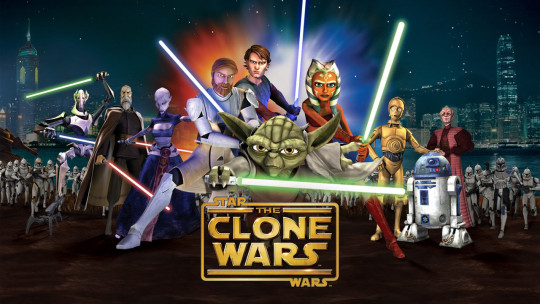
This review is part of a series of pieces on the entirety of the Star Wars canon. See them all here!
To preface this article, I want to try and point out the absurdity of following an article written about two films and a comic mini-series with an article written about six seasons of television, a comic mini-series, and a full-length novel. If you’re wondering why it has taken so long for me to get this part written, here’s your answer: there is just so much to write about that even after watching The Clone Wars all the way through, I wasn’t sure of where to start. We’re going to break this down by season though, starting by analyzing the first film and then tackling the show season by season until we reach the third. As for seasons 4-6, the comic, and the novel, expect me to cover them in my next installment.
Star Wars: The Clone Wars

When I first saw the theatrically released Star Wars: The Clone Wars, I was incredibly dismayed. I thought it was a disgrace to have a Star Wars film released in theaters when that film told such a gutless story, took no risks, and had next to no consequence within the story’s universe. To be perfectly frank, I think all of that is still pretty true. The film tells the story of Anakin and his new apprentice, Ahsoka Tano, being called away from a battle on the world Christophsis in order to rescue the son of Jabba the Hutt (yes, you read that right, Jabba has a fucking kid), and it quickly devolves into four seemingly separate “episodes” that never actually feel like a full story but technically are all connected. The ridiculousness of this plot combined with a bad sense of humor brings it down, and there is no way this film deserves to be a part of the theatrical Star Wars canon.
But, just because the film fails as a theatrically released Star Wars film doesn’t mean that it fails on other terms. See, this “film” isn’t really a film, but rather a bafflingly marketed and constructed television pilot that combines four episodes meant to introduce the characters of The Clone Wars TV show and set up the lighthearted tone the show holds onto for its first season. In that respect, Clone Wars actually works. Each of the four set-pieces of the pilot all accomplish different things: the first set-piece on Christophsis establishes Anakin and Obi-Wan’s relationship as it will play out for the rest of the show and introduces Ahsoka Tano, surprisingly selling Anakin taking her on as an apprentice pretty well; the second section introduces the clone army as actual characters, rather a faceless proxy army, Captain Rex, and Asajj Ventress while letting us see Anakin’s first attempts at being a teacher; the third set-piece introduces Padme Amidala and the political and underworld arenas of Coruscant she’ll reside in; and the fourth set-piece introduces Count Dooku as he will be presented throughout the entire series, allowing Christopher Lee to transition him from an adversarial mastermind into an over-the-top campy villain.
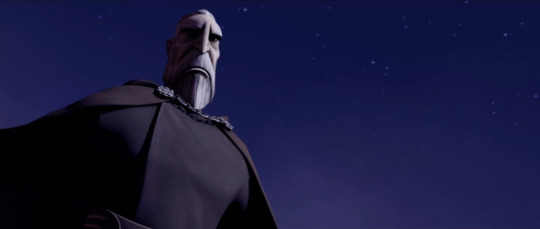
Don’t get me wrong. As far as TV pilots go, it’s a little underwhelming and not the most interesting thing you’ll ever see (even if you’re grading it on a curve for being the pilot of an animated kids’ show). But it works a damn sight better as a TV pilot than it ever could as a feature film, and had it aired as a two-hour special on Cartoon Network like was originally planned, it would not have gotten nearly the level of backlash it did from fans and critics like me who found it intensely underwhelming.
That’s really it. There isn’t much to talk about with this film. It has a consistently annoying tone, no real thematic tissue holding things together, and the performances by most of the actors are fairly underwhelming. The only standouts on display are Christopher Lee, reprising his role as Count Dooku for the final time (I know it’s been said, but this guy seriously never gave a bad performance in his career), Samuel L. Jackson, reprising his role as Mace Windu (you could make the same argument with this guy too), and Matthew Wood, who voices the battle droids in this film. Now, let’s be real, the decision to make the battle droids constant comedic cannon fodder is dumb, but Matthew Wood sells it like a pro, imbuing the droids with a level of personality that makes their poorly written attempts at comedy come off as charming, and when the writing of these jokes improves across the series, Wood is right there ready to use that material to make the droids pretty funny at times.
Star Wars: The Clone Wars (Season 1)
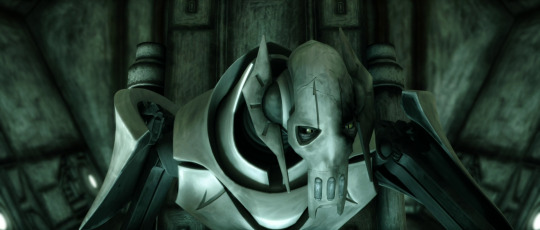
This is probably the best time to point out that Star Wars: The Clone Wars is really weird to watch because for some unfathomable reason it was aired, written, and produced out of chronological order. This makes viewing it chronologically on Netflix a pain, because you have to bounce around a whole lot just to see the first three seasons in their proper order, and as a result you see glimpses of the improvements in writing and storytelling from the later seasons but are still forced to sit through the slog of the first season that’s only interested in telling safe, episodic stories that don’t challenge the characters or the audience in any significant way. For what it’s worth, it’s still probably the best order to view the series in, as it paints a much more complete picture of the Clone Wars itself, but I found myself annoyed with the logic of airing and producing the episodes out of order, regardless of whether I watched it in the order it aired or the chronological order.
This strange ordering of episodes also isn’t helped by the fact that it pushes the series premiere episode, which is a genuine delight, to being seen after about five episodes and the feature film pilot. It is definitely a better introduction to the goals and aims of the writers than the feature film ever was.
The premiere episode of The Clone Wars follows Yoda on a diplomatic mission to persuade the king of the Toydarians to join the Republic. The episode’s main conflict arrives when Yoda’s vessel is attacked by a Separatist warship and he must land on the surface with only three clones by his side. Meanwhile, Count Dooku and Asajj Ventress are attempting to lure the king of Toydaria into joining the Separatists by proving to him that the Separatists are more capable of protecting him and his people than the Jedi and the Republic. Ventress challenges Yoda to make it to their location by nightfall, and Yoda accepts, battling an army of droids with the help of those clones in order to reach the king.

This is a fairly basic premise with clearly defined stakes and characters, and in the hands of George Lucas, it probably would have turned into twenty minutes of Yoda engaging in meaningless conflict where he doesn’t run into any significant challenges. In the hands of Dave Filoni’s team, however, this episode becomes a chance to reclaim the character of Yoda as he was presented in the original trilogy, and it’s truly amazing to see this Yoda again. Unlike in the entirety of the prequel trilogy, the Yoda we get to see is not the introspective mopey Yoda, but the silly, unpredictable guru that pranks Luke in order to test and teach him. Yoda’s students in this episode are the clones that travel with him, and he asserts to them that they are not the same faceless drones that Lucas intended, but unique individuals with differing skills and internal lives. Filoni’s team even has the wisdom to play Yoda’s strange behavior and unpredictability directly into fight scenes, as he outthinks droids with ease and uses risky strategies to play the droids’ advantage in numbers against themselves. By letting us see Yoda the incorrigible trickster again, The Clone Wars lets us know that it cares about recapturing the wonder and magic of the original trilogy, and that makes this first episode an incredible introduction to the show.
This episode also makes clear another one of Filoni’s goals, albeit in a much subtler manner. As I mentioned last time, the Toydarians as they are presented in The Phantom Menace are a harmful racial caricature of Jewish people, and that racism makes parts of The Phantom Menace pretty difficult to watch. This episode, however, hints at the way the Toydarians will be treated throughout the rest of the show. It shows the Toydarians as a peace-loving people that draw on a cultural heritage with an uncanny resemblance to ancient Judaism. This comes through far less in this episode than it does in later episodes, but throughout the show, the Toydarain people are essentially the equivalent of the Kingdom of Israel under the rule of King Solomon. They are incredibly wealthy and influential, they have a rich, long-standing culture, and they are ruled by a wise King who ultimately desires nothing but peace. I will admit that my connection with my Jewish heritage is a bit weak, so I am not the best person to judge whether this is still hurtful, but it seems to me that by keeping the Toydarian connection to Judaism and replacing racial caricature with a connection to a great cultural heritage, Filoni’s team effectively reclaims the Toydarians. This isn’t to say that their work makes the racism of the first film any less hurtful–far from it–but it adds a dimension to this alien race that, in my eyes, makes them far less hurtful to be associated with.1
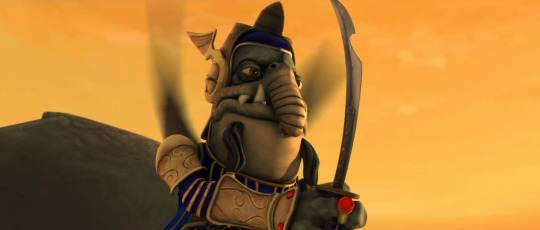
Most of the rest of the first season doesn’t quite hit the heights this episode does, but that doesn’t mean there aren’t solid episodes throughout. Some standouts are “Rookies,” which introduces us to the character Fives as he and other newly deployed squadmates fend off a commando droid attack; “Lair of Grievous,” which is twenty minutes of General Grievous kicking serious ass when Dooku betrays him and sets a trap for him in his own home; “Dooku Captured,” where we first meet the pirate scoundrel rapscallion Hondo Ohnaka (voiced by the ever perfect Jim Cummings) after he captures Count Dooku; “Trespass,” which introduces us to the Talz people and sets up an interesting conflict between an authoritarian military society and a young woman who believes in the power of diplomacy; and “Hostage Crisis,” wherein a group of bounty hunters hold a group of Senators and Anakin hostage in order to break Ziro the Hutt out of prison.
There are two episodes in Season 1 that manage to be as strong if not stronger than the premiere and those episodes are “Jedi Crash” and “Defenders of Peace.” These episodes contain some downright excellent storytelling. They challenge Ahsoka by making her face the potential death of her master, forcing her to come to terms with the Jedi Code’s requirement to remain unattached, and they then quickly challenge the entirety of the Jedi order. We meet the Lurmen, a pacifist group of monkey-like creatures that culturally resemble aboriginal and African tribes, and they explain to the Jedi that their role in the Clone Wars has spread more pain and suffering across the galaxy than it has relieved. Their chief even points out the hypocrisy of the Jedi espousing a philosophy of peace while taking on a role as military generals! The episode moves from that point to challenge the Lurmen chief, as he must accept that pure pacifism isn’t an adequate philosophy when their village is attacked by Separatist forces testing out an experimental weapon, and the younger generation has to stand up and fight so the older generation’s insistence on absolute pacifism doesn’t get them all killed.
It’s seriously really good. And George Takei is in it too. Go watch it now even if you’ve already seen it. I promise you’ll thank me afterwards.
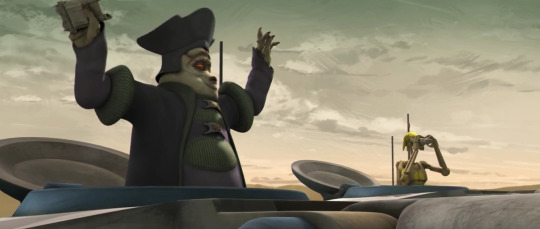
What’s wrong with the rest of the season then? Well, nothing really major. It’s passable kids’ television, but most of the episodes I haven’t mentioned by name don’t offer any challenges at all. The closest we get are in the episodes set on Ryloth, wherein a revolutionary insurgent is forced to work with a Senator he believes is corrupt and uncaring (who on the reverse believes the insurgent to be power hungry and after control of the planet), but these two characters aren’t given enough screentime beforehand for this to be meaningful to us. The other episodes are even worse, with the episodes surrounding the Separatist battleship Malevolence being solely concerned with sending the characters on MacGuffin quests and having them triumph due to Anakin being a better military strategist than Grievous. It’s fine, and well-constructed I guess, but it’s honestly pretty boring and uninteresting, and the next time I watch this show, I imagine I’ll be skipping past most of these episodes.
Star Wars: The Clone Wars (Season 2)

The second season of Clone Wars is about as solid a season of television as I can possibly imagine.
To be clear, it’s not the greatest season of television I have ever seen. But damn is it good. Pretty much every single episode in this season either challenges the characters personally, raises the stakes for conflict in the universe, or calls the morality of the Republic and Jedi Order into question. It starts off with “Holocron Heist,” in which badass bounty hunter Cad Bane breaks into the Jedi Temple and steals a holocron for Darth Sidious in order to kidnap Force-sensitive children across the galaxy. And then there’s “The Deserter,” where Captain Rex meets a clone trooper who went AWOL and established a family on an unoccupied planet, “The Mandalore Plot,” which has Mandalorians being awesome and Obi-Wan being a massive flirt, “Cat and Mouse,” which has Anakin piloting a stealth fighter against a Separatist general who is literally the only person who knows how to fight against those…
If I wanted to, I could spend a lot of time writing about each and every episode and their strengths, but that would take way too long, so you’re just going to have to trust me when I say that the entire season is solid as hell. Instead, we’re going to take a look at two standout story arcs that take place over multiple episodes in Season 2 and dissect them in detail to look at why they work as well as they do.
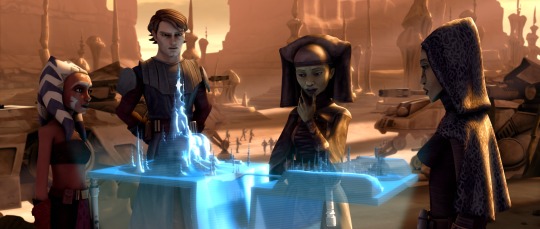
The first arc we’re going to look at are the episodes that follow Anakin, Ahsoka, Obi-Wan, Barriss, and Luminara as they lead Republic forces in the Second Battle of Geonosis in order to destroy a droid factory that has been recaptured by Separatist forces. Our heroes arrive with a massive Republic force, but the Separatists have them outnumbered even still. Their plan doesn’t survive first contact with the enemy, and Anakin and Ahsoka are forced to fight their way through immense odds just to get to their original landing point. After they are reunited, Anakin and Luminara work together to serve as a distraction while Ahsoka and Barriss sneak into the droid factory in order to plant explosive charges and stop the production of endless reinforcement for the Separatists.
What makes “Landing at Point Break” and “Weapons Factory” special isn’t really their plot. The mission our heroes are on isn’t particularly complicated, nor is it even that novel of a story idea (especially considering that we’ve already seen a pretty boring Battle of Geonosis in Attack of the Clones). These episodes are special because they completely shatter the perception of the Jedi as genuinely unstoppable warriors that dominates the prequel trilogy and most of the episodes of this show. Anakin and Ahsoka’s fight to reach Obi-Wan is desperate, and while at no point do they stop being powerful warriors, they are quickly forced to turn to clever tactics and their wits in order to get past the Separatist forces that would block them from their goal.
That same desperation is present in Ahsoka and Barriss’s quest to infiltrate the droid factory. They’re forced to sneak through behind enemy lines, going through a hornet’s nest where any wrong move will get them caught and lead to their failure. And you know what the writers decide to do? They have Ahsoka and Barriss make one mistake, wake one Geonosian, and when that Geonosian catches up to them, their mission is nearly brought to complete failure and they are forced to bunker down in a droid assault tank in order to both set off their own explosion and have a chance at survival. They are then stuck underneath a mountain of rubble and debris with little oxygen, and Ahsoka only barely manages to send out a signal to Anakin using her communicator, letting him know they’re still alive and leading him to continue the search until they’re rescued. These episodes are tense and filled with danger, and I find it genuinely impressive that Filoni’s team was able to get such great mileage out of a story that so easily could have turned into a retread of the battle from Attack of the Clones.
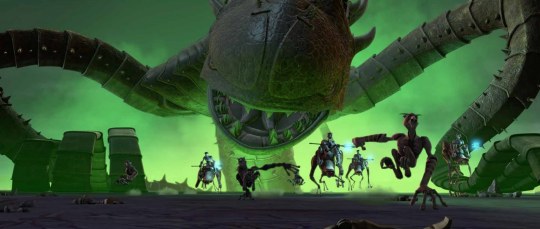
The next two episodes we’re going to look at are “The Zillo Beast” and “The Zillo Beast Strikes Back,” which besides being regrettably named, are filled with some of the most interesting and challenging material in this series. These episodes follow Anakin and Mace Windu, whose use of an electro-proton bomb on the planer Malastare causes an ancient beast to awaken in a clear nod to the Godzilla film franchise. This beast is genuinely fearsome, as its scales are strong enough to resist even a lightsaber, but Mace Windu and Anakin argue against Malastare’s leaders, who want to kill the Zillo, as to do so would be to take the innocent life of a creature that is the last of its kind. Anakin is eventually able to argue that the creature’s impervious scales would be useful for military research, so he and Mace Windu devise a plan to stun the beast and take it back to Coruscant, in order to trick the Malastare leaders into believing it is dead. When the Zillo arrives on Coruscant however, Palpatine quickly pushes to kill the beast using Malastare fuel, which the creature is weak to, and when his scientists fail to administer a lethal dose, the Zillo breaks free and wreaks havoc on the streets of Coruscant in a number of clear nods to Godzilla and King Kong. Eventually, the Jedi are able to kill the beast by hitting it with a lethal dose of fuel, and despite the lives they managed to save, all of the Jedi deeply regret the loss of the Zillo beast’s life.
The nods to Godzilla and King Kong are some of the coolest things about these episodes, but beyond that, these episodes have some pretty challenging thematic content. For one, this is the first time we get to see the Jedi Order faced with a legitimate moral dilemma, as for a lot of reasons, killing the Zillo is pretty defensible, but it still goes in direct violation of their Code. They decide against killing the Zillo, but because of their use of deception and pragmatist arguments, the Zillo ends up being put in a place where it will have even more power to do harm, close to a person who wants it to harm people so it can be put down rather than kept alive. In a lot of ways, Anakin and Mace Windu’s decision to bring the beast back to Coruscant is reckless and misguided, and we are shown just how blind the Jedi are to the dark forces that surround them on their homeworld. It is this blindness that leads them to do the very thing they sought to avoid: taking the life of an innocent creature that is likely the last of its kind. The shadows of the Dark Side are everywhere, and when the Jedi are too blind to see their own mistakes, innocents like the Zillo end up suffering more than the Jedi ever will.
Star Wars: The Clone Wars (Season 3)
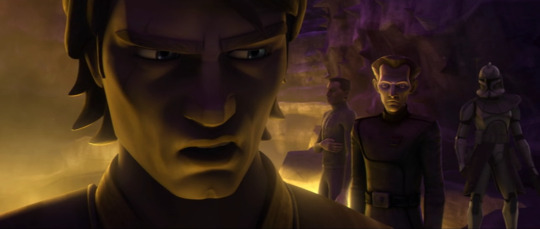
This is where it starts to get incredible.
Like, really fucking incredible beyond anyone’s wildest expectations.
Season 3 of The Clone Wars does more to expand the mythology of the Star Wars Universe than George Lucas has done since the release of Return of the Jedi.
I hear what you’re saying. “Jacqueline, how can you possibly make that claim? Lucas made three prequel films after Jedi that included important details on the world of Star Wars, the Republic, and Jedi Order that it’s impossible for a single season of television to outdo that.” Lucas did a lot after Jedi, and I am not trying to deny him or his importance to this universe. George Lucas, however, was entirely wrapped up in his goal of telling a story about a fascist government’s rise to power, and in focusing on those political details, he lost sight of the wonder and mystique that makes the Star Wars Universe as compelling as it is. Dave Filoni and his team, however, do everything they can to further Lucas’s message in the prequel trilogy, and they do that without losing sight of the fascinating mysticism surrounding the Force, the prophecy of the chosen one, and the tug and pull of balance between light and darkness that defines the universe.
Now, there legitimately isn’t a bad episode in this season, but like last time, two arcs told over multiple episodes rise to the top and that’s what we’re going to focus on.

The first arc that does this is the Nightsisters arc, which follows Asajj Ventress after she is betrayed by Count Dooku and left for dead. She manages to survive her ship being fired upon by another Separatist warship, and she returns to her home planet to the witches of Dathomir in order to find her heritage and get help in her quest for revenge against her former master. She and the seemingly invincible witch Mother Talzin first target Dooku directly, sending Ventress and two Nightsisters in with cloaking magic and a poison designed to weaken Dooku and make him easy to kill. Dooku is still a force to be reckoned with, however, and he dispatches Ventress and her sisters without significant difficulty. Ventress and Talzin then hatch a more sinister plan, testing the males on the far side of Dathomir until they find one who is worthy and take control of his mind so he can be planted as a traitor in Dooku’s ranks. When Dooku takes this man, named Savage Oppress,1 under his wing and trains him as an apprentice, Ventress sneaks into Dooku’s vessel and makes Savage turn on his new master. Her plan fails, however, and Savage quickly regains control of his mind and turns on the both of them, escaping back to Dathomir and seeking guidance from Mother Talzin, who tells him of a “brother” he must seek while showing him a vision of the Sith Lord Darth Maul, a Zabrak and Dathomir Nightbrother just like him.
We’ll talk about Maul next time, when we actually get to see him in action, but suffice it to say, closing out a set of episodes that explores the dark mysticism of the Star Wars Universe by promising the return of one of Star Wars’ most badass villains is a pretty risky decision, as is the depth of exploration of the Dark Side that we get to see here. The Nightsisters are absolutely fascinating on their own as a less-than-savory mystical underbelly that neither identifies as Jedi or Sith, and Mother Talzin is an imposing figure who, if she did not prefer to keep to herself and her coven, would be a far greater threat to the galaxy than the Sith could ever dream of being.
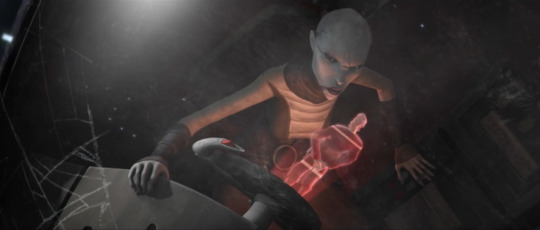
Of course, the main attraction of these episodes is that they finally put Asajj Ventress to use as the complex character she was always meant to be. Ever since I was a little girl watching Genndy Tartakovsky’s Clone Wars animated mini-series, I’ve been obsessed with this character. She has such a rich and tragic backstory, and as a young girl with her own demons boiling up under the surface, Ventress appealed to me with her mastery of the Dark Side, dual lightsabers, and dominatrix-like attitude (which is turned up to a ten in The Clone Wars, as she is referred to as Mistress by everyone around her). Up until Season 3 though, The Clone Wars didn’t really put her to good use. Sure, she was an assassin, and she had those dual lightsabers, but in this show she has been far less of a pure, unadulterated badass, as she’s the villain and the heroes have to beat her.
These episodes turn that on its head perfectly. Dooku’s betrayal of her makes sense, in only the way an abuser’s decision to abuse can; she has consistently failed to achieve victory against the Jedi after all, and as we see her backstory unfold over a few short flashbacks, watching her being taken from her family as a child and witnessing the murder of the Jedi who taught her how to use the Force, Dooku’s betrayal becomes an opportunity for her to finally exert some agency over all of the horrible things that have happened to her. She will have revenge against Dooku, because damnit, this is the first time she’s ever been powerful enough to strike back against the people who have hurt her the most. It becomes even more heart-wrenching to watch as any knowledge of the prequel trilogy’s storyline lets us know that she is doomed to fail in her quest for revenge, as Dooku survives until Revenge of the Sith to be killed by Anakin Skywalker. Despite having the power to strike back against her master with “dark magicks” and a monstrous warrior, she still ends up without enough power to take any emotional closure for herself through revenge.

The second arc of note in this season is the arc set on the planet Mortis, following Anakin, Ahsoka, and Obi-Wan as an ancient distress signal calls them to an incredibly strange planet.
But I’m not going into detail on those episodes.
They are amazing. Make no mistake.
But I would not dare spoil the details of what happens in them to anyone who hasn’t seen them.
Trust me, just take my word on this, and go on Netflix, to Season 3 of Star Wars: The Clone Wars, and watch “Overlords,” “Altar of Mortis,” and “Ghosts of Mortis” right now. If you don’t watch anything else from this show (and seriously, you should, it’s great), then still watch these episodes. You don’t even need that much context to enjoy them, because as long as you accept that Anakin has an apprentice named Ahsoka, literally anything else you could need to know follows logically from Anakin and Obi-Wan’s characterizations in the prequel films. You have my word, a Jacqueline Merritt guarantee, that you won’t regret the time you spend checking these episodes out.
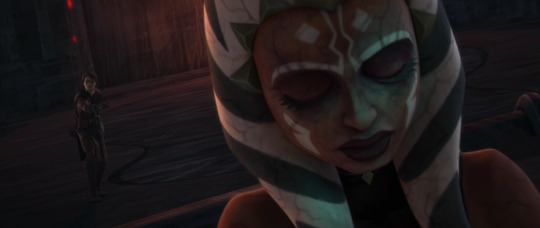
Next time, hopefully not two months from now, we’ll explore the rest of The Clone Wars, the comic Darth Maul: Son of Dathomir, and the novel Dark Disciple. See you then!
Critical Eye Criticism is the work of Jacqueline Merritt, a trans woman, filmmaker, and critic. You can support her continued film criticism addiction on Patreon.
1Any of my Jewish readers who disagree with my belief that the Toydarian’s are less hurtful because of their characterization in The Clone Wars are more than welcome to challenge me on that, as I am open to hearing any criticism of my argument here.
2I could also go into more detail on the character of Savage Oppress and how he is actually quite fascinating despite having an absolutely terrible name, but exploring his character is best left for our exploration of Darth Maul in the later seasons, as their arcs are fairly closely intertwined.
#star wars#star wars the clone wars#the clone wars#tcw#ahsoka tano#anakin skywalker#obi-wan kenobi#master toda#count dooku#christopher lee#george takei#ashley eckstein#star wars canon#skip this one too#i am posting it primarily because i want it to be up here#but again#if you want good discussion/analysis of clone wars#listen to A More Civilized Age
7 notes
·
View notes
Note
3, 5 and 29 for the writer asks, please!
Ooh, fun! Thank you, anon!
Full Ask List Here
3. What’s your favorite fic that you’ve written?
However Improbable, my Star Trek TOS/ACD Sherlock Holmes crossover written for NaNoWriMo a loooooong time ago.
It was my very first TOS fic (why I chose to do a novel-length crossover as my initiation is anyone's guess), and to this day is still probably the most fun I've had writing anything. I'd like to think I balanced the characterization of both universes fairly well, but the reader is the judge.
Crossovers can be tricky, and they're not for everyone, but I had far too much fun with this one. I will always remember it fondly.
5. What’s a fic idea you’ve had that you will never write?
At one point, I had a Star Trek TOS Alternate Universe series plotted out based on the OG Mission Impossible television show (from the same general time period as TOS, and as fabulous in its own way). The show actually featured Leonard Nimoy for two of the seasons, and it's generally delightful. Much more so than the big-budget films of the same franchise, in my humble opinion. 8/10, would recommend.
(Plot under the cut)
If I remember correctly, the AU started on the premise of Operation-Annihilate going badly wrong (an idea which later morphed into An Equitable Trade, FWIW), whereupon Jim Kirk was quietly discharged from Starfleet service in the ensuing scandal, and Spock basically said live long and fuck off with that and followed him. In this AU, the rest of the crew weren't originally aboard the Enterprise, and were picked up along the way through the ensuing ridiculous adventures across the galaxy, per typical MI format.
I actually had one 'episode' partially written a long time ago, before I got smart enough to back things up online, and lost it in a laptop crash. RIP my most ridiculous idea.
29. Share a bit from a fic you’ll never post OR from a scene that was cut from an already posted fic. (If you don’t have either, just share a random fic idea you have that you don’t plan on getting to.)
This was cut last month from one of my Whumptober fics, as I decided to go a couple different directions with the TOS movie era instead.
“What on earth are you doing.”
Seated on the couch with at least a dozen takeout containers of various shapes and sizes stacked in perfectly neat, consistently spaced rows on the coffee table, Spock raises an eyebrow at him. “It was indeed, on Earth. During our recent sojourn in the Terran past, you informed Dr. Taylor that I found Italian food to be pleasing.”
“…Yes? Is that why you ordered what looks like the entire vegetarian menu from Angelo’s?”
“I must have a full data set in order to confirm a valid hypothesis.”
“Of course.” He doesn’t even bother to hide a smile. “But your face tells me it hasn’t been confirmed.”
“Correct.” Spock looks mildly uneasy about this discrepancy, though he indicates the barely-touched cartons with what looks like resignation. “I admit to feeling a slight sense of disillusionment, in the matter. It would seem that either you were in error, or that my taste for such things has changed during the process of my refusion.”
Jim’s too tired to do this standing up, right now, so he clambers over a hilariously untidy stack of of cartons on the rug (clearly overflow from the table) in order to collapse on the couch as well, exhaling in a long breath of relief at being able to get off his feet for a few minutes.
“I mean, it’s certainly possible your tastes have changed, Spock. But I think it’s more likely that you just haven’t got the right dishes.”
“How precisely is one to know which are ‘right’.”
Jim turns his head, still resting on the back of the couch, and gestures at the pile of cartons. “You like Italian, typically pasta; but you dislike strong garlic flavor. Since garlic is pretty ubiquitous in Italian food, when we order in or go out, we typically ask them to make yours without much of it.”
“Ah.”
“Angelo’s has a pumpkin ravioli this time of year that you refuse to admit is your favorite, because favorites are illogical.”
“I did not see this option on the menu.”
“That’s because since it’s seasonal, it’s not on the carryout menu,” he replies. “You’ve complained more than once about having to call and actually talk to someone to order it, instead of using the automated system.”
“I did not recall that detail with any clarity,” Spock admits, looking more downcast than before.
He reaches over to put a steadying hand on Spock’s arm. “You’ve recalled nearly every detail that is important; we can deal with the rest. That’s what I’m here for,” he says quietly.
“I have taken enough advantage of your patience in the matter.”
“Incorrect. You’ve never taken advantage of me or anyone else, that I can recall. I’m not sure it’s even in your nature.”
“That appears to be a highly subjective assessment fueled by an emotional viewpoint.”
“Well, I am an emotional human. So that viewpoint is logical for me.” Seeing Spock’s clearly baffled expression, he hastens to add, “But from the Vulcan viewpoint: I do have all my memories, so I think my opinion should be trusted more than yours in the matter.”
Spock considers this for a moment, and then nods. “That is eminently logical.”
2 notes
·
View notes
Text
FANTASY TV GUIDE ADS
Sequels, Spinoffs, and Reboots We Never Saw - But Wish We Had!

Ads and listings from a Papermoon Loves Lucy fantasy issue of TV Guide!

"The Real Housewives of Beverly Hills” ~ Before Andy Cohen there was Don Loper - TV’s first gay man with a doting bevy of housewives at his command. At press time, Mrs. Alan Ladd was replaced by Mrs. Ricky Ricardo. In the premiere, Loper stages a benefit for Share and Mrs. Ricardo gets a sunburn. Sponsored by Unguentine.

"American Picker” ~ In this episode, Dan picks over some old furniture at a run-down brownstone in New York City. Mid-century modern is Jenkins’ specialty and tonight he strikes gold.

"Hot Bench” ~ Today: “The Case of the Damaged Television & Fractured Friendship”. Judge Moroni Olsen and Bailiff Bobby serve justice at 4 ET / 3 CT.

“Desi’s Desert Island Discs” ~ Premiere! Desi’s first guest is Ricky Ricardo. Viewers are treated to excerpts from his top ten. Special appearance by Lucy Ricardo singing “Sally Sweet”.
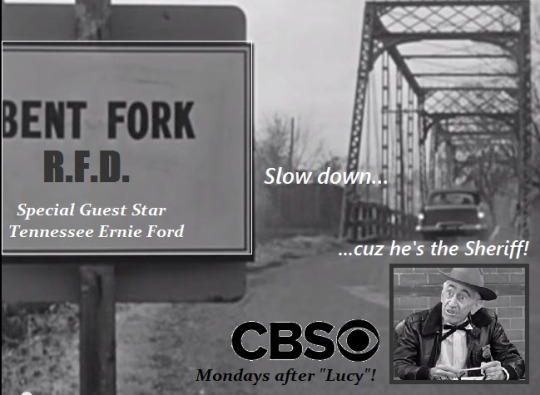
“Bent Fork R.F.D.” ~ This week the Sheriff (Will Wright) arrests a Pontiac full of Yankees headed for Hollywood. Guest star Ernie Ford tries to pawn off Teensy and Weensy (the Borden Sisters) on the westbound travelers, but they get all tied up.

“My Big Fat Fabulous Life” ~ Premiere! In this musical docuseries, Teensy and Weensy are profiled at their mobiel home in Tennessee. It’s a “Ricochet Romance” when the girls become obsessed with the Bent Fork BBQ Buffet - and it goes bankrupt.
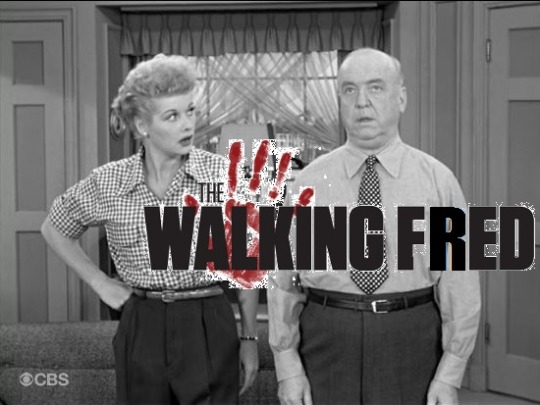
“The Walking Fred” ~ Fred turns into a walker after losing $500 to Al Hergesheimer (Milton Berle), an undead used car salesman from Brooklyn. Sponsored by Pontiac.
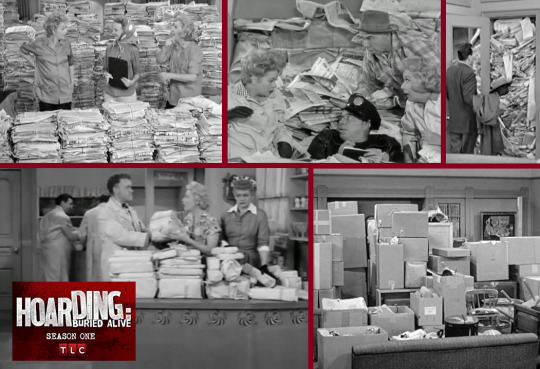
“Hoarding: Buried Alive” ~ In the season premiere: a woman is buried alive by two sides of beef; two urban couples are presumed lost in a collection of cardboard boxes; and old newspapers take over the lives of several desperate homeonwers.
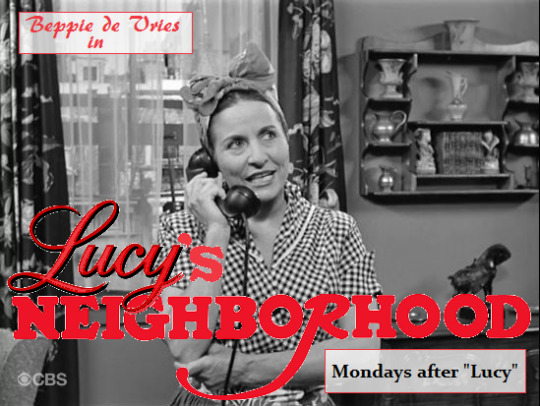
“Lucy’s Neighborhood” ~ Beppe de Vries stars in this all-new spin-off to “East 68th Street”. In this episode, Mrs. de Vries sees a wacky neighbor on the ledge and goes to great lengths to get her psychiatric help. Guest star Joseph Kearns as Doctor Toim Robinson.

“Freddie Filmore’s Drag Race: Females are Fabulous!” ~ Season 15 of the long-running show welcomes Carson Kresley and Michelle Visage in their first appearances since “Rupaul’s Drage Race Season 87″. This year’s guest judges include Phil Spitalny, Countess Blublitzki, and Fredrika.
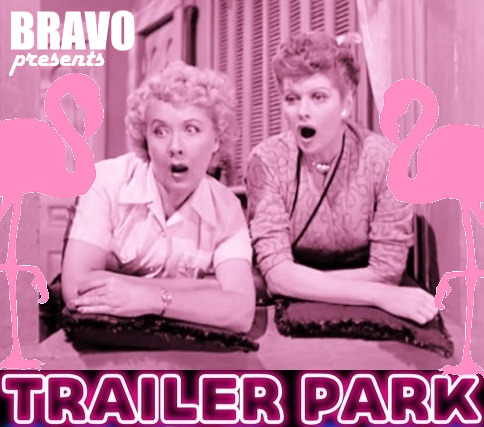
“Trailer Park” ~ Lucy and Ethel move into a trailer park outside West Jamestown. There they keep an eye on the comings and goings of the flirty Flamingo Sisters (Gloria and Joan Blondell). Tonight: Mrs. Trumbull’s cat gets sick from an out-of-date can of All Pet.
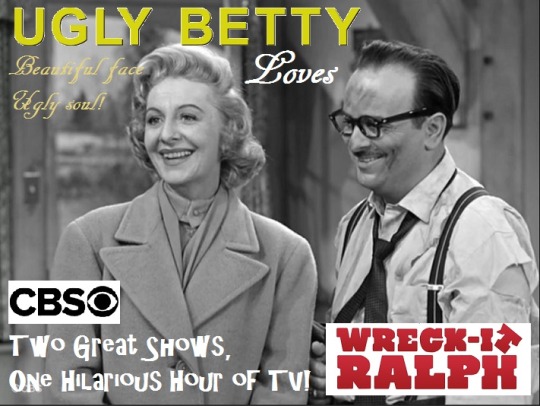
“Ugly Betty Loves Wreck-It Ralph” ~ In this all-new teaming of two popular CBS sitcoms, the Ramseys (Mary Jane Croft and Frank Nelson) find a litter of kittens hidden in the chicken coop. Meanwhile, Little Bruce (Ray Ferrell) discovers hundreds of baby chickens in the litter box.

“Night of the Living Fred” ~ A television adaptation of the popular zombie film. In the new series, a landlord / zombie (Fred Mertz) eats the tenants of his New York City brownstone, until he is unmasked by Sergeant Nelson (Frank Nelson).
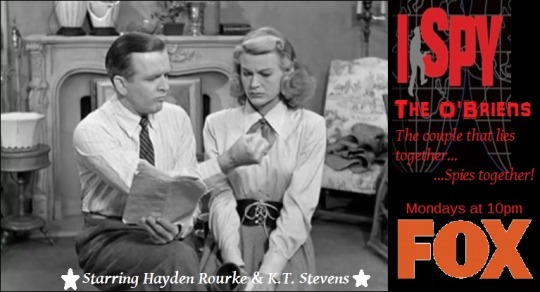
“I Spy: The O’Briens” ~ Hayden Rorke and K.T. Stevens play international spies masquerading as actors playing international spies on a television series about actors playing international spies. Tonight: Tom breaks a lamp and neighbor Lucy (Lucille Ball) impersonates a chair.

“Big Brother: The Twins Twist” ~ This season welcomes Teensy and Weensy, Timmy and Jimmy Hudson, the Harpo Twins, and special guests Patty and Cathy Lane - all competing to be the last houseguests in the brownstone. Julie Chen Moonves McGillicuddy hosts.
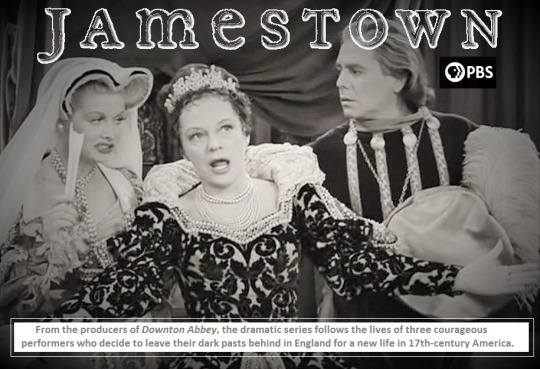
“Jamestown” ~ From the producers of “Downton Abbey,” this dramatic series follows courageous performers who leave their dark pasts behind in England for a new life in 17th-century America. Tallulah Bankhead plays Elizabeth, the Quinn of Jamestown. Friar Quinn is played by William Frawley. Tonight’s episode “The Quinn’s Lament” was written by Quinn and Madelyn Martin.

“The Taylors in 3D” ~ The first spinoff from Desilu’s impossibly successful “I Love Lucy” starring Gene Reynolds and Mary Ellen Kay as young newlyweds who move into a Manhattan brownstone haunted by hilarious ghosts. Elizabeth Patterson plays Matilda, the new landlady and part-time medium, Reya.

“The Carmichael Show” ~ In this reboot of “The Lucy Show”, Viv and Sherman have moved out, leaving the Carmichaels to make it on their own. In the pilot episode, Lucy cancels plans to move to Los Angeles and Jerry’s Military School rejects his application. Chris becomes a waitress to pay the tuition.
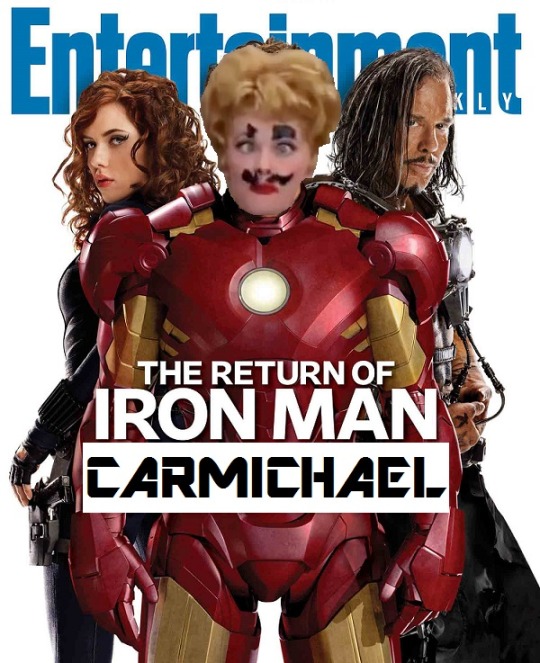
Based on the hit series, “Iron Man Carmichael”, this all new TV movie marks the return of fearless stunt performer and housewife Lucy Carmichael as she takes on the Marvel Multiverse.
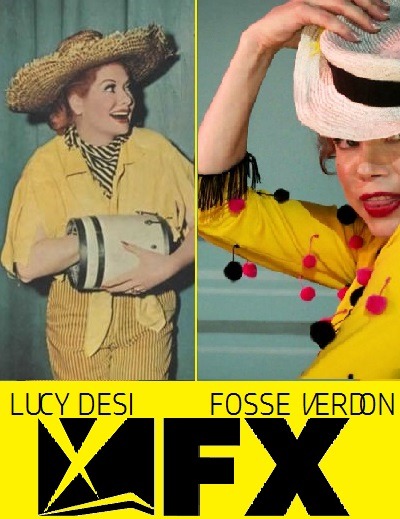
In the tradition of “Fosse Verdon” FX brings us “Lucy Desi”. Follow the tumultuous romance and career of Lucille Ball and Desi Arnaz as they climb the ladder of showbusiness success.

“Feud: Lucy and Joan” ~ A docudrama television series created by Ryan Murphy in the footsteps of “Bette and Joan”. Based on the legendary real-life feud between Lucille Ball and Joan Crawford. 8 episodes of nail-biting drama and shouting.
#TV Guide#Lucille Ball#Vivian Vance#Desi Arnaz#TV#Joan Crawford#Gwen Verdon#Tallulah Bankhead#Hayden Rorke#K.T. Stevens#Mary Jane Croft#Frank Nelson#Don Loper#Hans Conried#Moroni Olsen#Will Wright#The Borden Twins#The Lucy Show#I Love Lucy#The Lucy-Desi Comedy Hour#Jimmy Garrett#Candy Moore#Gene Reynolds#Mary Ellen Kay#Beppe DeVries
4 notes
·
View notes